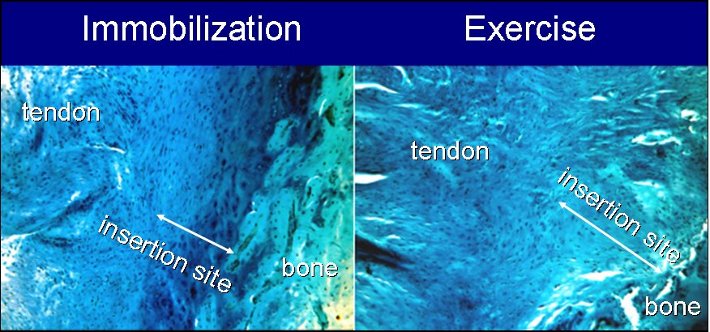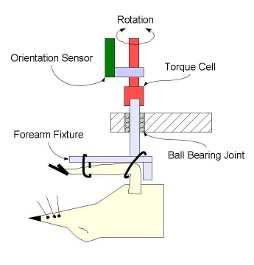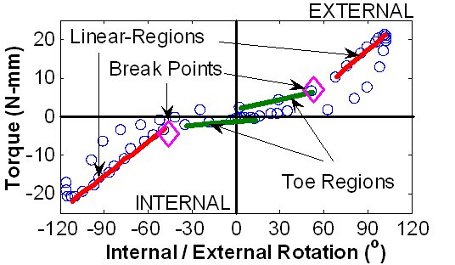Rotator Cuff Tendon to Bone Insertion Site Healing
The ability of rotator cuff tendons to heal back to bone following injury is limited. As a result, surgical repairs often fail. Many factors such as age, time since initial injury and tissue quality contribute to this high failure rate, but are beyond the surgeon's control. Post-operative activity, on the other hand, can be modulated. Unfortunately very little data regarding the effect of post-operative activity on tendon to bone healing in the shoulder are available to guide clinicians.
To address this lack of data, our laboratory has developed a rotator cuff repair surgical model in the rat. Using this animal model, we have shown that immobilizing the shoulder improved the biological, structural and mechanical properties of the repaired insertion site compared to either caged-activity or exercise (Thomopoulos et al., 2003).

Based on these results, we now hypothesize that a period of immobilization will be necessary to 'protect' the insertion site and to allow for appropriate extracellular matrix (ECM) expression (e.g., type and III collagen, aggrecan, decorin and biglycan) such that the insertion site can re-form. Only after the insertion site has reformed, can the positive effects of exercise (via remobilization) be realized. Unfortunately, immobilization is also known to cause joint stiffness, and it is this concern about joint stiffness, that has driven current clinical practice to begin passive motion soon after rotator cuff repair.
Using our rat rotator cuff repair model, the goals of the REMO project, funded by a grant (5R01AR051000) from the National Institute of Arthritis and Musculoskeletal and Skin Diseases at the National Institute of Health, are to:
- Determine if remobilization following a short (2 weeks), intermediate (6 weeks) or long (10 weeks) period of immobilization can improve the biological, structural and mechanical properties of the repaired insertion site compared to continuous immobilization.
- Determine if remobilization will reduce joint stiffness of repaired shoulders compared to continuous immobilization.
- Determine if passive motion will reduce joint stiffness in repaired shoulders compared to continuous immobilization.
- Determine if passive motion will reduce repaired insertion site biological, structural and mechanical properties compared to continuous immobilization.


Effect of Passive Motion
As stated above, immobilization increased joint stiffness, albeit transiently, in our animal rotator cuff repair model. We therefore conducted a study to determine if periodic passive motion would reduce this increase in joint stiffness, as has been shown to occur in both animal and human studies following tendon repair in the hand. Surprisingly, 2 weeks of passive motion increased joint stiffness and reduced the range of motion compared to continuous immobilization, and furthermore, 4 weeks or remobilization did not reduce this loss in joint function [Peltz et al., 2008a;2009a).
Exercise Following Immobilization
Short Immobilization Period (2 weeks):As expected, exercise following only 2 weeks of immobilization, resulted in inferior repaired insertion site mechanical properties (Peltz et al., 2008b).
Moderate Immobilization Period (6 weeks):As expected, immobilizing the shoulder reduced joint function (increased stiffness and decreased range of motion) initially, but this reduction was, again, transient (Peltz et al., 2009b). Furthermore, exercise following a moderate period of immobilization did not have a significant effect on repaired insertion site mechanical properties (Peltz et al., 2009c).
Long Immobilization Period (10 weeks):We are currently collecting this data.
For more information see:
- Thomopoulos S, Williams GR, Soslowsky LJ. Tendon to bone healing: differences in biomechanical, structural, and compositional properties due to a range of activity levels. J Biomech Eng 125:106-113, 2003.
- Sarver JJ, Peltz CD, Dourte L, Reddy S, Williams GR, Soslowsky LJ. After rotator cuff repair, stiffness--but not the loss in range of motion--increased transiently for immobilized shoulders in a rat model. J Shoulder Elbow Surg 17(1 Suppl):108S-113S, 2008.
- Peltz CD, Dourte LM, Sarver JJ, Kim SY, Williams GR, Soslowsky LJ. Immobilization with Daily Passive Motion Causes Detrimental Changes in Shoulder Joint Mechanics in a Rat Model of Rotator Cuff Injury and Repair. Trans Orthop Res Soc 33:251, 2008a.
- Peltz CD, Dourte LM, Kuntz AF, Sarver JJ, Kim SY, Williams GR, Soslowsky LJ. The effect of postoperative passive motion on rotator cuff healing in a rat model. J Bone Joint Surg Am 91:2421-2429, 2008b.
- Peltz CD, Dourte LM, Sarver JJ, Kim SY, Williams GR, Soslowsky LJ. Exercise Following Immobilization Is Detrimental to Tendon Properties and Joint Mechanics in a Rat Rotator Cuff Injury Model. Trans Orthop Res Soc 34:1504, 2009a.
- Peltz CD, Dourte LM, Kuntz AF, Sarver JJ, Williams GR, Soslowsky LJ. Range of Motion Loss Is Transient Following Six Weeks of Immobilization in a Rat Model of Rotator Cuff Repair. Trans Orthop Res Soc 34:1895, 2009b.
- Peltz CD, Dourte LM, Kuntz AF, Sarver JJ, Williams GR, Soslowsky LJ. Following a Moderate Period of Immobilization, Tendon Properties and Joint Mechanics Are Not Altered With Exercise. Trans Orthop Res Soc 34:1896, 2009c.
